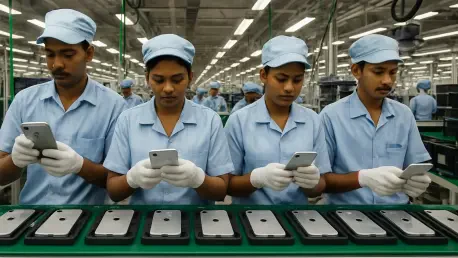In a world where global supply chains are constantly reshaped by economic pressures and geopolitical tensions, a seismic shift is unfolding in the smartphone industry, with Apple at the forefront of this transformation. The US market, long dependent on China for the bulk of its smartphone imports, is witnessing an unprecedented pivot toward India as a manufacturing powerhouse. This change, driven by strategic decisions from tech giants, reflects not only a response to external challenges but also a proactive effort to diversify production bases. Apple’s role in this transition is particularly striking, as the company has dramatically increased its manufacturing footprint in India, altering the dynamics of where and how devices are made for American consumers. This development raises critical questions about the future of global production networks, the impact on market competition, and the broader implications for international trade. As this shift gains momentum, understanding the forces behind it and the outcomes it may yield becomes essential for grasping the evolving landscape of technology manufacturing.
A Dramatic Shift in Manufacturing Origins
The landscape of smartphone production for the US market has undergone a profound change in recent times, with India emerging as a central hub. According to recent data from Canalys, the share of smartphones made in China for American consumers has plummeted from a dominant position to just 25% in the latest quarter. Meanwhile, India’s contribution to US smartphone imports has soared to an impressive 44%, reflecting a staggering 240% year-on-year growth in manufacturing volume. Apple stands as the primary catalyst for this shift, with over 75% of iPhones sold in the US now originating from Indian facilities. This marks a significant departure from previous years when reliance on Chinese production was the norm. The rapid pace of this transition underscores a deliberate move to reorient supply chains, driven by both strategic foresight and external pressures. Such a dramatic realignment not only reshapes import patterns but also signals a broader trend among tech companies looking to mitigate risks associated with over-dependence on a single manufacturing region.
Beyond the raw numbers, this shift carries deeper implications for how supply chains are structured to serve the US market. Apple’s focus on India aligns with its “China Plus One” strategy, which seeks to diversify production away from China to reduce exposure to geopolitical uncertainties and trade disruptions. India, with its burgeoning workforce and supportive government policies, has become an attractive alternative for scaling up manufacturing. This isn’t merely a reaction to immediate challenges but a calculated long-term plan to build resilience into global operations. While Apple leads this charge, the ripple effects are felt across the industry, prompting other manufacturers to reassess their own production strategies. The surge in India-made devices also reflects a growing confidence in the country’s ability to meet the stringent quality and volume demands of premium smartphone brands. As this trend continues, the balance of manufacturing power in the tech world is tilting in ways that could redefine competitive dynamics for years to come.
Geopolitical and Economic Drivers
The reorientation of smartphone supply chains toward India cannot be fully understood without considering the geopolitical and economic forces at play. Tensions stemming from tariff disputes and trade policies, particularly those intensified during recent US administrations, have accelerated the allocation of India-made devices to American markets. These policies have created an environment where diversifying production bases is not just advantageous but necessary for mitigating financial risks. Simultaneously, India’s “Make in India” initiative has played a pivotal role by imposing import tariffs that incentivize local manufacturing. For Apple, this has meant a strategic push to establish a robust presence in the country, capitalizing on both cost advantages and policy support. The result is a supply chain divergence, where the majority of iPhones destined for the US are now produced in India, while other regions like Europe continue to rely heavily on Chinese-made units.
Economic factors further amplify India’s appeal as a manufacturing destination for Apple and its peers. The country’s growing middle class presents a dual opportunity—serving as both a production base and an expanding consumer market for premium devices. This demographic shift, coupled with fierce price competition in the local market, encourages companies to invest heavily in Indian operations. While Apple has taken the lead, other major players like Samsung and Motorola are also increasing their manufacturing activities in India, though at a more cautious pace. Samsung, for instance, continues to lean on Vietnam for much of its production, while Motorola partners with local firms to establish a foothold. This collective movement toward India reflects a broader industry consensus that the region offers a viable path to balancing cost, quality, and market access. As these economic and geopolitical currents converge, they are reshaping the very foundation of how smartphones reach American hands.
Strategic Foresight and Industry Trends
Apple’s pivot to India is not a spontaneous reaction but the result of years of strategic planning aimed at diversifying its global supply chain. The company has steadily scaled up its production capacity in the region, investing in partnerships with local manufacturers and enhancing infrastructure to meet the demands of the US market. This long-term vision is evident in the dramatic rise of India-made iPhones, which now dominate Apple’s American sales figures. Beyond immediate production goals, this approach serves as a hedge against risks tied to over-reliance on any single country for manufacturing. Apple’s nuanced strategy also includes maintaining a presence in China, as seen in plans for new retail outlets there, while simultaneously expanding elsewhere. This balanced approach highlights a commitment to flexibility and adaptability in an unpredictable global environment, setting a benchmark for how tech giants navigate complex supply chain challenges.
The broader smartphone industry is taking note of Apple’s moves, with varying degrees of adoption among competitors. While Apple spearheads the shift to India, other premium vendors are following suit, albeit with different priorities and timelines. The potential for growth in India’s premium market, especially as consumer purchasing power rises, is a significant draw for these companies. Additionally, innovations like Apple’s upcoming Advanced Manufacturing Academy in the US, focused on integrating artificial intelligence and smart techniques, suggest that lessons learned from India could influence global production strategies. Meanwhile, fluctuations in shipment patterns, such as inventory adjustments to preempt tariff impacts, reveal the intricate dance of planning and execution in this space. As Apple continues to monitor competitors’ performance, including Samsung’s mixed results with new models, the industry braces for further shifts that could redefine manufacturing norms and market expectations.
Looking Back at a Transformative Journey
Reflecting on the past, Apple’s leadership in redirecting smartphone supply chains toward India marked a turning point for the US market. The dramatic increase in India-made iPhones, alongside a sharp decline in reliance on Chinese production, reshaped industry priorities in a remarkably short span. Geopolitical tensions and economic incentives converged to create a fertile ground for this transition, with Apple’s strategic foresight guiding the way. This shift wasn’t just about numbers; it represented a fundamental rethinking of how global supply chains could operate under pressure. The involvement of other major players, though at a slower pace, confirmed that this was no fleeting trend but a sustained movement toward diversification.
Moving forward, the focus should be on addressing lingering challenges, such as local competition and the impact of tariffs, to ensure the stability of this new manufacturing landscape. Stakeholders must also consider how India’s role can evolve beyond production to innovation, potentially fostering homegrown technologies that complement global demands. Apple’s journey in India offers a blueprint for balancing risk and opportunity, and the next steps involve deepening investments in skills and infrastructure to sustain this momentum. As the smartphone industry continues to navigate an ever-changing world, these actionable strategies will be crucial in shaping a resilient and dynamic future for US supply chains.









